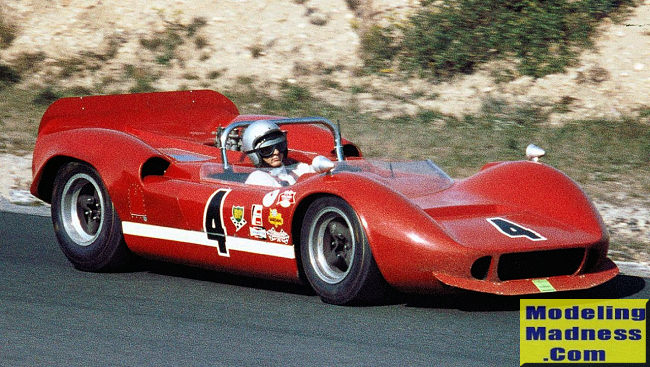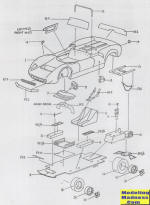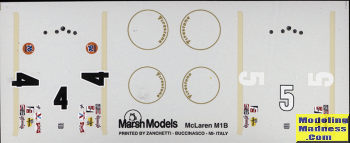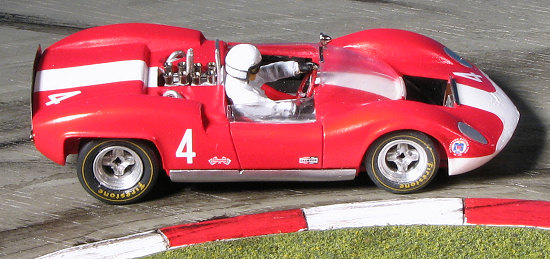
Thundersport 1/43 1966 McLaren M1B
| KIT #: | MM49 |
| PRICE: | $50.00 when new in 1999 |
| DECALS: | Two liveries |
| REVIEWER: | Scott Van Aken |
| NOTES: | Multimedia kit |

| HISTORY |
The McLaren M1A, and its derivatives, the McLaren M1B and the McLaren M1C, are a series of mid-engined Group 7 sports prototype race cars built by McLaren, between 1963 and 1968. The M1A was the team's first self-designed and developed sports car. Later versions, such as the 'M1B' and 'M1C', competed and raced in the North American Can-Am series, starting in 1966 season. The car was raced in North America and Europe in 1963 and 1964 in various Group 7 and United States Road Racing Championship series events. 24 examples of the M1A and M1B were built, and 25 examples of the M1C were manufactured. They were powered by a few different motors, including Chevrolet small-block engine, an all-aluminum Oldsmobile V8 engine, a Chevrolet big-block engine, and even a Ford FE engine. It was constructed out of a tubular space frame chassis, and, combined with its light weight of 551 kg (1,215 lb) this gave it a great power-to-weight ratio. The 4.5 L (270 cu in) Oldsmobile V8 engine developed around 310 hp (230 kW), while the 350 cu in (5.7 L) Chevrolet small-block V8 engine was capable of developing over 550 hp (410 kW), and 538 lb⋅ft (729 N⋅m) of torque. This drove the rear wheels through a Hewland L.G.500 four-speed manual transmission.
The M1A was campaigned during 1964 and 1965 meeting with some success. The M1B was an updated car with a new body and other improvements, developed in 1966. While winning several USRRC events, it was unsuccessful in terms of the Can-Am though Bruce McLaren did end up 3rd in the Championship thanks to steady finishes. The Mk1C was the customer car for the 1967 season while Team McLaren raced the dominant M6A, winning 5 of the 6 events.
| THE KIT |
 This
is the Mk1B car (sometimes referred to as the McLaren-Elva Mk.II). Typical of
Marsh Models' Thundersport series, it has a resin body, chassis and some smaller
parts. Most of the parts count consists of cast metal the photo etch parts. The
p.e. is steel and not brass so is not only quite strong, but will require some
effort to remove the parts from the sheet. There is a well appointed interior
with p.e. belts and other details.
This
is the Mk1B car (sometimes referred to as the McLaren-Elva Mk.II). Typical of
Marsh Models' Thundersport series, it has a resin body, chassis and some smaller
parts. Most of the parts count consists of cast metal the photo etch parts. The
p.e. is steel and not brass so is not only quite strong, but will require some
effort to remove the parts from the sheet. There is a well appointed interior
with p.e. belts and other details.
The rear of the car has a block for the transmission casing along with a place to attach the downdraft carburetors. There is also a nicely done exhaust system that is held up with p.e. Rubber tires are provided for the aluminum wheels and the inserts.
 Instructions
are basically an exploded view that is more than adequate to build the kit. The
modeler will need to do a bit of thinking regarding when to attach parts as some
will need to have gluing delayed until after the body/interior are painted. The
parts listing provides the color information for each part and also includes a
color chip for the somewhat dark red overall color. Two livery options are
provided. The #4 car was driven by Bruce McLaren while the #5 car was driven by
Chris Amon. The decal sheet is nicely printed and despite being 25 years old, I
fully expect it to function well.
Instructions
are basically an exploded view that is more than adequate to build the kit. The
modeler will need to do a bit of thinking regarding when to attach parts as some
will need to have gluing delayed until after the body/interior are painted. The
parts listing provides the color information for each part and also includes a
color chip for the somewhat dark red overall color. Two livery options are
provided. The #4 car was driven by Bruce McLaren while the #5 car was driven by
Chris Amon. The decal sheet is nicely printed and despite being 25 years old, I
fully expect it to function well.
| CONCLUSIONS |
While I've not built the Mk.IB, I have built the McLaren Elva Mk.IA which is shown below. The kit makes into a very nice model and is one that a modeler who has a few multi-media kits under their belt should have no trouble with. Probably the only trouble will be finding one of these as when they are found, it is not unusual for sellers to be asking $200 for them.

April 2024
Copyright ModelingMadness.com. All rights reserved. No reproduction in part or in whole without express permission.
If you would like your product reviewed fairly and fairly quickly, please contact the editor or see other details in the Note to Contributors.